The psychology and subconscious power of color is a topic that has been heavily tested and studied over the years. According to the Color Marketing Group, color plays a part in 85% of total sales. Here are a few ways you can incorporate color into your store!
Snap Judgment
As customers walk into a store, they form a subconscious judgment within the first 90 seconds. Experts say that roughly 62% to 90% of this judgment is based on color alone. Warm colors, such as oranges and browns, are calming and encourage customers to linger in your space. Orange is especially proven to make people happy. Cooler shades, like blues and greens, create a calming environment. Pink is relaxing and provides relief from tension and stress.
Add color to your store by incorporating colorful accents or painting your walls; you can even purchase paint-grade slatwall for a totally customizable look. Another option is adding colorful mannequins, which is a new trend for making your merchandise pop while also tying your store’s color scheme together. Look for colorful accent pieces that are also functional for displaying merchandise.
Build Your Brand
Color plays a vital role in establishing your brand identity in the customer’s mind. Store logos, signage, and advertisements work best when tied together with a signature shade. This concept isn’t limited to the colors you have within your store. Think of the items customers take with you when they leave your store. Brightly colored bags that match your store’s colors are a great silent advertisement for your brand. Many successful retail store are easily identifiable by their signature bags, such as Victoria’s Secret pink striped bags or Forever 21’s bright yellow bags.
If purchasing an entire new inventory of bags isn’t in your store’s budget, adding colored tissue paper is another easy and affordable way to incorporate color into your store’s packaging. Coordinating hangtags, ribbon, and other small touches will help build your brand in the customer’s eye.
Signage
Ever wonder why most sale signs are red? Red is associated with warnings and danger, so the human mind is trained to perceive messages in this color as urgent and important, making red the perfect color to capture a customer’s attention.
Yellow is the first color perceived by the retina and a time-tested color for getting a customer’s attention. Like red, yellow is associated with stopping. Customers brains are wired to stop when they encounter these colors. Be careful not to overuse bright reds and yellows, however, as too much of these colors can be jarring to the eye.
Remember, elements of color are meant to visually enhance your product and shouldn’t be too distracting. A little goes a long way! With the proper design, branding and execution, though, color can work with your product instead of against it.

